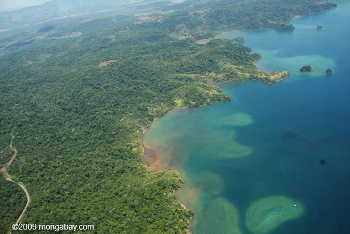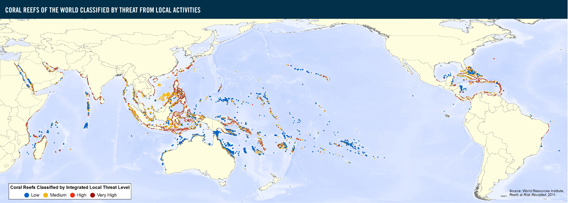Marine scientists have been warning for years that coral reefs, the most biodiverse ecosystems in the ocean, are facing grave peril. But a new comprehensive analysis by the World Resources Institute (WRI) along with twenty-five partners ups the ante, finding that 75% of the world’s coral reefs are threatened by local and global impacts, including climate change. An updating of a 1996 report, the new analysis found that threats had increased on 30% of the world’s reefs. Clearly conservation efforts during the past decade have failed to save reefs on a large-scale.
“This report serves as a wake-up call for policy-makers, business leaders, ocean managers, and others about the urgent need for greater protection for coral reef,” said Dr. Jane Lubchenco, under secretary of commerce for oceans and atmosphere and NOAA administrator, in a press release.
 Aerial view of coastal rainforests and coral reefs in Costa River. Photo by: Rhett A. Butler. |
According to the report, titled Reefs at Risk Revisited, 60% of the world’s coral reefs are already impacted by local pressures, such as overfishing, destructive fishing practices such as using dynamite, coastal development, and pollution from both land sources and sea. Globally, coral reefs are imperiled by greenhouse gas emissions: coral bleaching from rising sea temperatures and ocean acidification due to higher carbon dioxide levels are hurting reefs worldwide. This double dose of local and global impacts will put 90% of world’s reefs in danger in 20 years time, and close to 100% by 2050, if business continues as usual.
Southeast Asia coral reefs are currently the world’s most troubled with 94% already imperiled by local impacts.
Priceless resource
Coral reefs are not just one of the world’s most beautiful ecosystems, they also provide a wealth of ecosystem services for society. Reefs protect shorelines against storms and erosion, provide food security for some of the world’s poorest, draw tourism, and provide habitat for a quarter of the world’s marine species. Medicines for some of the world’s worst diseases—from cancer to AIDs to malaria—have also been found among coral species.
“At their core, reefs are about people as well as nature: ensuring stable food
supplies, promoting recovery from coral bleaching, and acting as a
magnet for tourist dollars. We need apply the knowledge we have to
shore up existing protected areas, as well as to designate new sites
where threats are highest, such as the populous hearts of the
Caribbean, Southeast Asia, East Africa and the Middle East,” said Mark Spalding, senior marine scientist at the Nature Conservancy and a lead author of the report.
Reefs at Risk identifies the nine most vulnerable nations to economic and social problems stemming from coral reef loss: Haiti, Grenada, Philippines, Comoros, Vanuatu, Tanzania, Kiribati, Fiji, and Indonesia.
 Great Barrier Reef in Australia. |
“The people at greatest risk are those who depend heavily on
threatened reefs, and who have limited capacity to adapt to the loss
of the valuable resources and services reefs provide,” explained Allison
Perry, project scientist at the WorldFish Center and a lead author.
“For highly vulnerable nations—including many island nations—there
is a pressing need for development efforts to reduce dependence on
reefs and build adaptive capacity.”
Saving corals
The report is not all gloom and doom, but puts forward solutions to the coral crisis. Already a quarter of the world’s coral reefs are already under some form of protection, however many of these are merely ‘paper park’s. According to the report 6% of the world’s coral reefs are in marine protected areas (MPAs) that are considered well-managed.
Locally, overfishing needs to be halted as well as damaging fishing practices such as dynamite fishing; coastal developments must be better planned; and pollution reduced. In addition, MPAs should be expanded and management improved.
To save coral reefs, however, will also require tackling global climate change through cutting greenhouse gas emissions, particularly carbon dioxide which is causing ocean acidification, according to the report.
“Coral reefs are valuable resources for millions of people worldwide. Despite the dire situation for many reefs, there is reason for hope,” said Lauretta Burke, senior associate at WRI and a lead author of the report. “Reefs are resilient, and by reducing the local pressures we can buy time as we find global solutions to preserve reefs for future generations.”

The world’s coral reefs as classified by their local threats. Map courtesy of WRI. Click to enlarge.
Related articles
Australia’s floods threaten Great Barrier Reef
(01/18/2011) The floods ransacking the Queensland coast have cost 20 lives and $500 million worth of property damage. Now, huge volumes of water are pouring into the ocean, threatening the Great Barrier Reef, which extends for thousands of kilometers off the coast. Although it may take years to know the full consequences of the flooding, Australian scientists are already warning of serious damage. For now, the biggest problems are concentrated on the southern part of the reef, where three overflowing rivers—the Burdekin, the Fitzroy, and the Burnett—have released millions of gallons of heavily polluted water into the sea. So far, prevailing winds have confined the majority of the floodwaters to within 65 kilometers of shore. But in time, the damage may grow to affect the entire reef system.
Photos: Scientists race to protect world’s most endangered corals
(01/11/2011) As corals around the world disappear at alarming rates, scientists are racing to protect the ones they can. At a workshop led by the Zoological Society of London (ZSL), the world’s foremost coral experts met in response to a decade of unprecedented reef destruction to identify and develop conservation plans for the ten most critically endangered coral species.
Atlantic ocean warming confirmed by corals
(01/05/2011) A new study investigating the ability of coral to record sea temperatures indicates that the Northwestern Atlantic has experienced unprecedented warming during the past 150 years.
Beyond gloom: solutions to the global coral reef decline
(11/10/2010) The world’s coral reefs are in trouble. Due to a variety of factors—including ocean acidification, warming temperatures from climate change, overfishing, and pollution—coral cover has decline by approximately 125,000 square kilometers in the past 50 or so years. This has caused some marine biologists, like Charlie Veron, Former Chief Scientist of the Australian Institute of Marine Science, to predict that coral reefs will be largely extinguished within a century. This year alone, large-scale coral bleaching events, whereby coral lose their symbiotic protozoa and become prone to disease and mortality, were seen off the coasts of Indonesia, the Philippines, and some Caribbean islands. However a new paper in Trends in Ecology and Evolution attempts to dispel the gloom over coral reefs by pointing to strategies, and even some successes, to save them.
Carbon emissions hurting coral recruitment
(11/08/2010) While research has shown that ocean acidification from rising CO2 levels in the ocean imperils the growth and survival mature coral reefs, a new study has found that it may also negatively impact burgeoning corals, by significantly lowering the success of coral recruitment. A study in the Proceedings of the National Academy of Sciences (PNAS) has found that coral recruitment could fall by 73% over the next century due to increasing acidification.
Groundbreaking research shows that rainforests and coral reefs create rainfall #BAD10
(10/15/2010) Coral reefs and rainforests seem to have little in common beyond the fact that they are both hotspots of diversity, yet groundbreaking research is showing how these different ecosystems—when intact—may actually seed clouds and produce rainfall.
Losing nature’s medicine cabinet

(10/04/2010) In all the discussions of saving the world’s biodiversity from extinction, one point is often and surprisingly forgotten: the importance of the world’s species in providing humankind with a multitude of life-saving medicines so far, as well as the certainty that more vital medications are out there if only we save the unheralded animals and plants that contain cures unknown. Already, species have provided humankind everything from quinine to aspirin, from morphine to numerous cancer and HIV-fighting drugs. “As the ethnobotanist Dr. Mark Plotkin commented, the history of medicine can be written in terms of its reliance on and utilization of natural products,” physician Christopher Herndon told mongabay.com. Herndon is co-author of a recent paper in the journal Biotropica, which calls for policy-makers and the public to recognize how biodiversity underpins not only ecosystems, but medicine.














